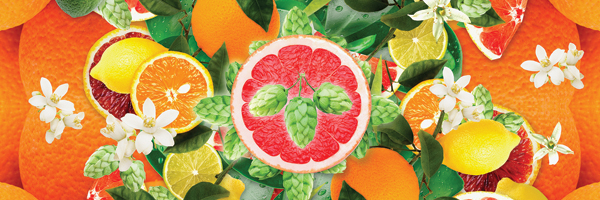Celebrating Hop Flavors: The Citrus Among Us
Our team of sensory experts explore some of the important, interesting and often unsung aspects of the hops’ flavor spectrum that are inspiring innovative brewers around the world to create exciting beers.

Welcome back to our blog series, Celebrating Hop Flavors. Here, John I. Haas’ team of sensory experts takes time to explore some of the important, interesting and often unsung aspects of the hops’ flavor spectrum that are inspiring innovative brewers around the world to create some of the most exciting beers you can imagine.
What comes to your mind when you hear the word “citrus”? Your answer likely depends upon where you grew up. If you are from Sicily, for instance, your whole childhood might have been filled with citrus flavors…perhaps in the form of “granita,” an icy frozen treat flavored with lemon or the sweet Italian after-dinner liqueur, limoncello. Plus, lemons are also a crucial part of almost any fish dish in Italy and they pair extremely well with garlic and parmesan cheese for pasta.
No matter where you live though, it’s likely that you have been surrounded by citrus. After all, citrus is one of the most popular flavors around the globe and a considerable industry has been built around its flavors. Lemon flavors and scents are everywhere in our everyday life—in cleaners and detergents, in carbonated beverages, in lemon tarts and cakes, and in countless sweets from our childhood days.
But the term “citrus” actually covers many more flavors than people typically assume. Lemon, orange, bergamot (a specific lemon type), lime, ginger, lemongrass, grapefruit, pomelo, tangerine…the list goes on. Not only is the juice of those fruits important, the peel and the leaves all contribute to citrus flavors—even the twigs contribute in the form of Petitgrain oil.
Chemically speaking, the most important aroma compounds for citrus flavors are linalool, linalyl acetate, myrcene and pinene, and some aldehydes and ketones—and yes, these compounds are also very important constituents of hop oil! When it comes to grapefruit flavor, thiols play an important role as 3-mercapto-hexanol and 3-mercapto-hexylacetate.
As broad as the spectrum of citrus flavor may be (consider the huge variety of differences in oranges and lemons alone!) the spectrum of citrus flavors in beer is just as dramatic. From soft lemon to strong zesty orange in New England IPAs—as if you were biting into a fruit! In hop-forward beers, we find very appealing, but also very unique, citrus flavors, from many different hop varieties that you’ll find in New-World and Old-World hops alike, including:
Aloha (composition blend)
Citra®
Mosaic®
Hallertau Tradition
Cascade
Ekuanot™
Comet
Galaxy™
Hersbrucker
Kazbek
Mandarina Bavaria
Brewing and fermentation technologies also play an important part in transferring citrus flavors in the final beer. Many of the citrus flavor compounds are polar and easily soluble, so they are not easily boiled off at higher temperatures.
Yeast strains can have a significant effect on citrus flavors. These delicate or powerful notes are transformed as slightly different molecular arrangements in the yeast support or suppress the citrus flavor in the beers. To achieve strong citrus flavors, try a combination of whirlpool and dry hopping (preferably at cold temperatures) and you should get very good results.
To learn more about the subtle and surprising flavors of hops—and to better understand the types of flavor profiles you can achieve—reach out to your John I. Haas sales representative. Or drop us a line here at the Haas Innovations Brewery anytime. We always love to hear from you.
Cheers!
